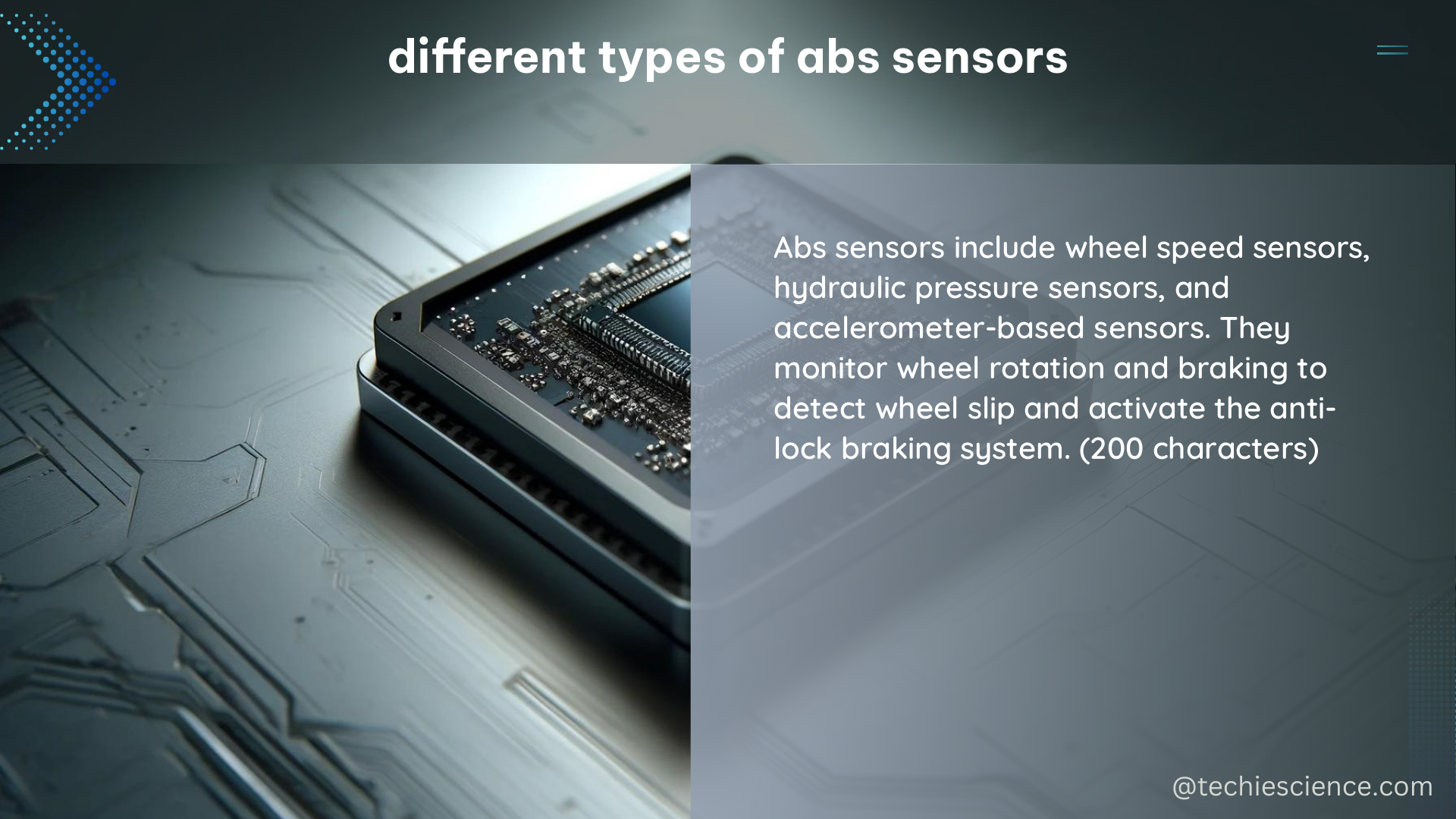Anti-lock Braking System (ABS) sensors are critical components that play a vital role in maintaining vehicle stability and control during emergency braking situations. These sensors monitor the rotational speed of each wheel and provide real-time data to the ABS control module, allowing it to precisely regulate the braking force and prevent wheel lockup. Understanding the different types of ABS sensors and their technical specifications is essential for both automotive professionals and DIY enthusiasts.
Wheel Speed Sensors
Wheel speed sensors are the primary ABS sensors responsible for measuring the rotational speed of each wheel. These sensors come in two main types:
Passive Wheel Speed Sensors
Passive wheel speed sensors use a toothed wheel or a reluctor ring attached to the wheel hub to generate a magnetic field. As the teeth pass by the sensor, they induce a voltage in the sensor coil, which is proportional to the wheel speed. The technical specifications of passive wheel speed sensors include:
- Sensor Type: Passive, inductive
- Sensor Range: Typically 0 to 200 mph (0 to 320 km/h)
- Sensor Accuracy: ±1% to ±3% of actual wheel speed
- Sensor Response Time: 1-2 milliseconds
- Sensor Output Signal: AC voltage, typically 0.5 to 12 volts peak-to-peak
- Sensor Environmental Specifications: Operating temperature range of -40°C to 125°C, vibration resistance up to 30 g
Active Wheel Speed Sensors
Active wheel speed sensors use a magnet or a Hall effect sensor to generate a voltage signal proportional to the wheel speed. These sensors do not require a toothed wheel or a reluctor ring, making them more compact and less susceptible to environmental factors. The technical specifications of active wheel speed sensors include:
- Sensor Type: Active, Hall effect
- Sensor Range: Typically 0 to 200 mph (0 to 320 km/h)
- Sensor Accuracy: ±1% to ±2% of actual wheel speed
- Sensor Response Time: 0.5-1 milliseconds
- Sensor Output Signal: DC voltage, typically 0.5 to 4.5 volts
- Sensor Environmental Specifications: Operating temperature range of -40°C to 150°C, vibration resistance up to 50 g
Yaw Rate Sensors

Yaw rate sensors, also known as lateral acceleration sensors, measure the angular velocity or the rate of change of the angle of the vehicle’s body around the vertical axis. This information is crucial for the ABS control module to determine the vehicle’s stability and adjust the braking force accordingly. The technical specifications of yaw rate sensors include:
- Sensor Type: Gyroscopic, accelerometer-based
- Sensor Range: Typically ±90°/s to ±300°/s
- Sensor Accuracy: ±1% to ±3% of actual yaw rate
- Sensor Response Time: 5-10 milliseconds
- Sensor Output Signal: Analog voltage, typically 0.5 to 4.5 volts
- Sensor Environmental Specifications: Operating temperature range of -40°C to 125°C, vibration resistance up to 20 g
ABS Sensor Installation and Troubleshooting
When working with ABS sensors, it is essential to follow the manufacturer’s guidelines and use the recommended tools and equipment to avoid damaging the sensors or the ABS system. Here are some key considerations for ABS sensor installation and troubleshooting:
- Sensor Location: Wheel speed sensors are typically located near the wheel hub, while yaw rate sensors are usually mounted on the vehicle’s body or chassis.
- Sensor Clearance: Ensure that the sensor has the proper clearance from the toothed wheel or reluctor ring to maintain accurate speed measurements.
- Sensor Wiring: Properly route and secure the sensor wiring to prevent damage and interference with other vehicle components.
- Sensor Diagnostics: Use a diagnostic tool or scan tool to check for ABS sensor-related trouble codes and perform sensor tests to identify any issues.
- Sensor Replacement: When replacing ABS sensors, always use the recommended OEM parts and follow the manufacturer’s installation procedures.
By understanding the different types of ABS sensors and their technical specifications, you can effectively diagnose, maintain, and repair the ABS system in your vehicle, ensuring optimal braking performance and safety.
References:
- NHTSA – ABS Sensor Types and Locations: https://www.nhtsa.gov/vehicle-safety/abs-sensor-types-and-locations
- ABS Sensor Technical Specifications: https://www.autozone.com/diagnostics-repair-manuals-shop-by-vehicle/abs-sensor-technical-specifications
- ABS Sensor DIY Guide: https://www.yourmechanic.com/article/how-to-replace-an-abs-wheel-speed-sensor

The lambdageeks.com Core SME Team is a group of experienced subject matter experts from diverse scientific and technical fields including Physics, Chemistry, Technology,Electronics & Electrical Engineering, Automotive, Mechanical Engineering. Our team collaborates to create high-quality, well-researched articles on a wide range of science and technology topics for the lambdageeks.com website.
All Our Senior SME are having more than 7 Years of experience in the respective fields . They are either Working Industry Professionals or assocaited With different Universities. Refer Our Authors Page to get to know About our Core SMEs.